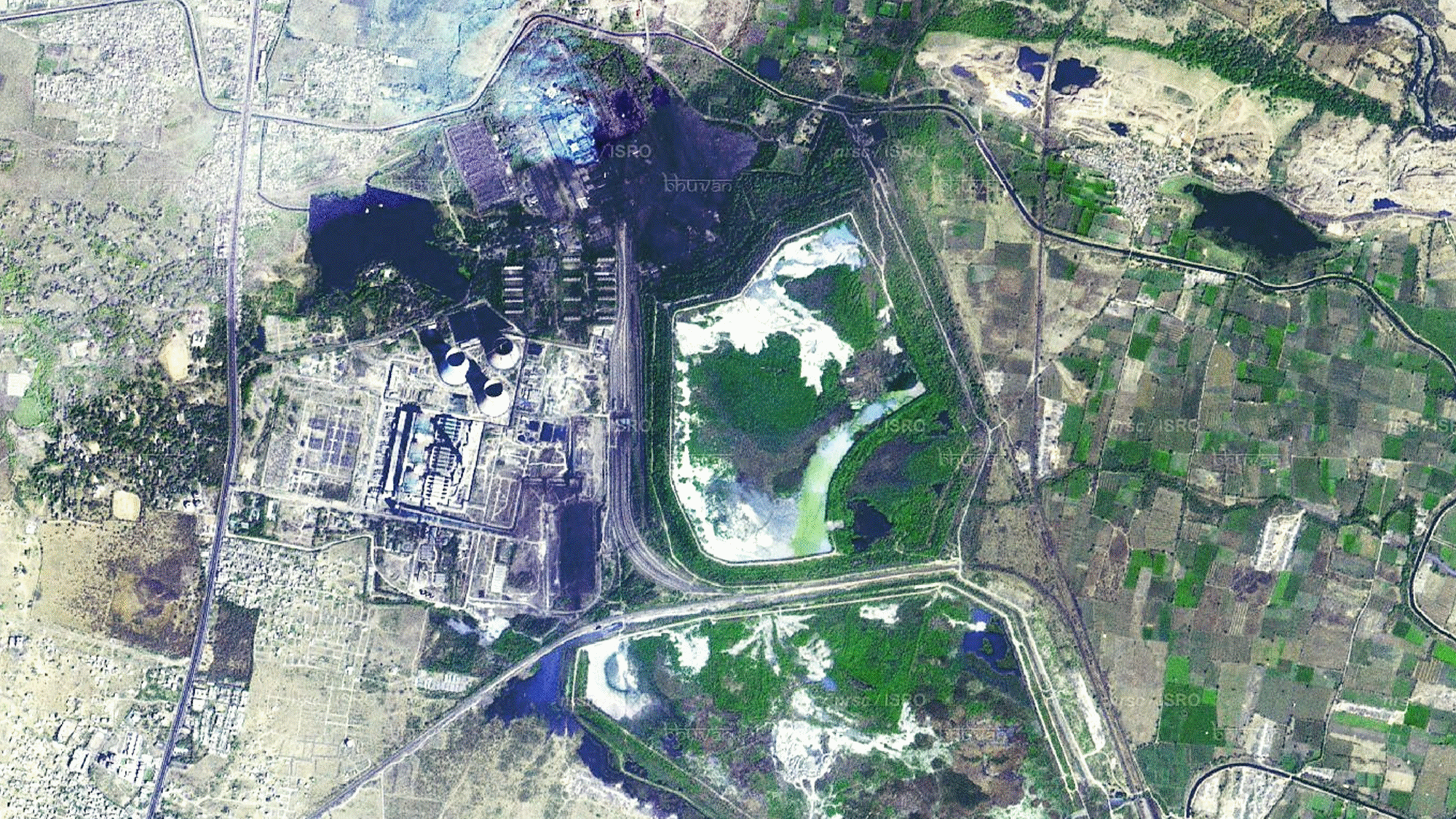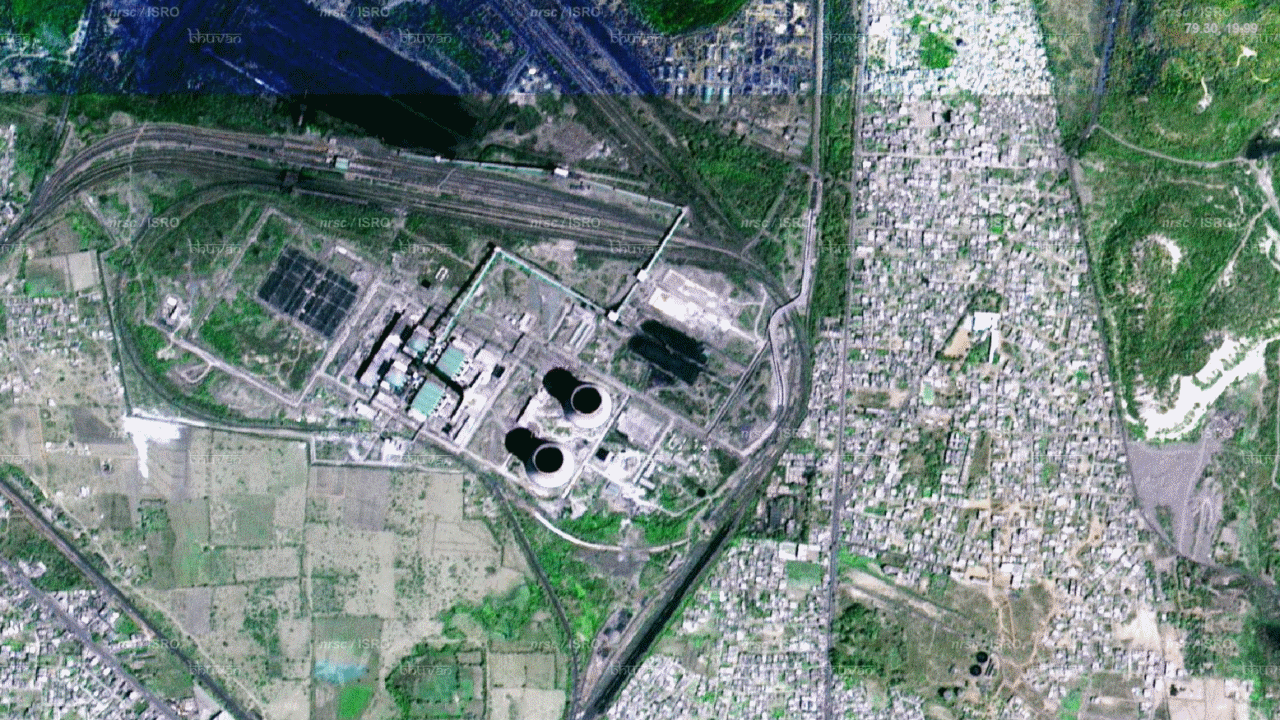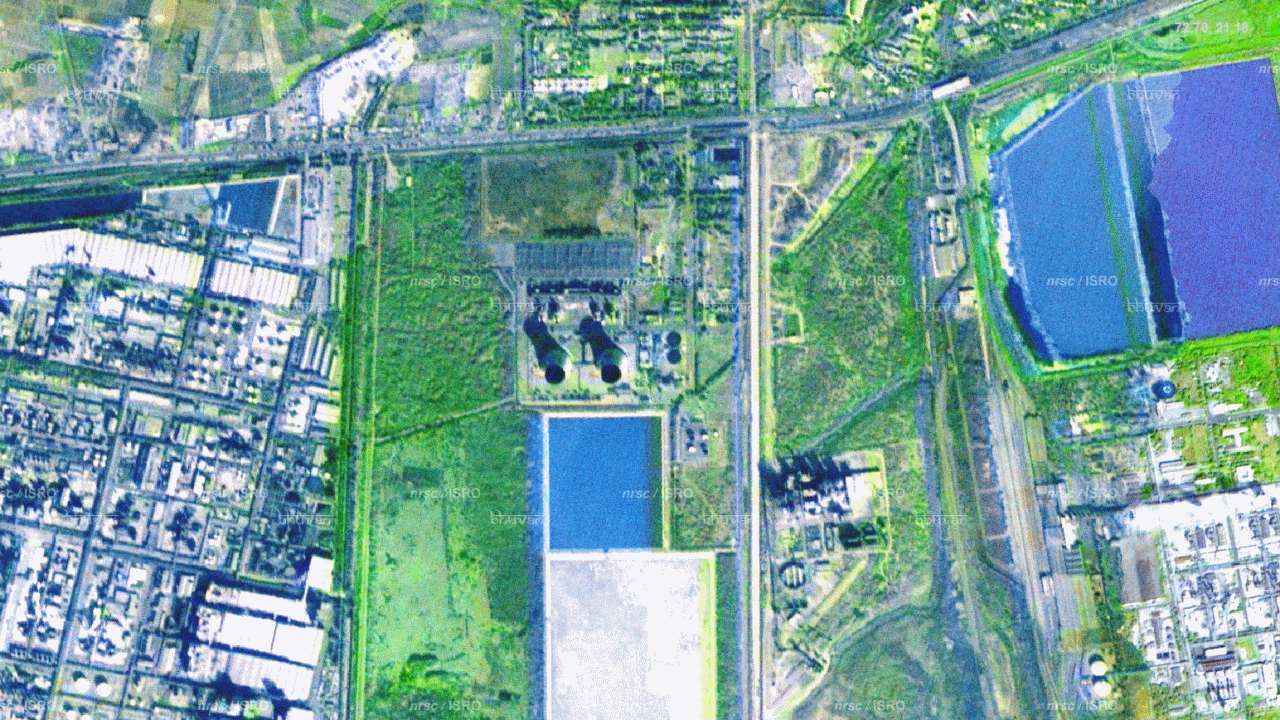[[en]]Thermal Power Plants[[hi]]थर्मल पावर प्लांट
[[en]]Thermal
power plants converts the heat energy of primary fuels such as coal,
to the electric power. In most of the thermal power stations,
combustion of primary fuels heats the water and transforms it to
steam. The steam drives steam turbines, which eventually generates
electricity. Subsequently, the steam is condensed and recycled back
into the system. The thermal power stations may use several
different types of heat sources, including fossil fuels, nuclear
energy, biomass and waste.[[hi]]थर्मल पावर प्लांट कोयले जैसे प्राथमिक ईंधन की ऊष्मा ऊर्जा को विद्युत ऊर्जा में परिवर्तित करते हैं।
अधिकांश थर्मल पावर स्टेशनों में, प्राथमिक ईंधन का दहन पानी को गर्म करता है और इसे भाप में बदल देता है।
यह भाप, भाप की टरबाइन चलाती है, जो अंततः बिजली उत्पन्न करती है।
इसके बाद, भाप को संघनित किया जाता है और प्रणाली में पुनर्नवीनीकरण किया जाता है।
थर्मल पावर स्टेशन कई अलग-अलग प्रकार के ताप स्रोतों का उपयोग कर सकते हैं,
जिनमें जीवाश्म ईंधन, परमाणु ऊर्जा, बायोमास और अपशिष्ट शामिल हैं।
[[en]]Types
of thermal power plants (Wikipedia):[[hi]]थर्मल पावर प्लांट के प्रकार (विकिपीडिया):
[[en]]Subcritical: [[hi]]सबक्रिटिकल:
[[en]]Operate at critical point of water
with temperature of 374°C and pressure 22.12 MPa.[[hi]]374° सेल्सियस तापमान और 22.12 एमपीए के दबाव के साथ पानी के क्रांतिक बिंदु पर काम करते हैं।
[[en]]Supercritical: [[hi]]सुपरक्रिटिकल:
[[en]]Operate at 500-600°C temperature and 24-26
Mpa Pressure.[[hi]]सुपरक्रिटिकल: 500-600° सेल्सियस तापमान और 24-26 एमपीए दबाव पर काम करते हैं।
[[en]]Ultra
Supercritical:[[hi]]अल्ट्रा सुपरक्रिटिकल: [[en]]Operate at 760°C
temperature and 34 Mpa Pressure.[[hi]]760°C तापमान और 34 एमपीए दबाव पर काम करते हैं।
[[en]]Supercritical
coal-fired power plants have higher thermal efficiency than
subcritical power plants due to their higher operation temperature
(500-600°C) and pressure (24-26 MPa) (Li & Wang, 2018). The
1980 MW Koradi Thermal Power Station in Maharashtra is a
Super-critical coal-fired power plant (Illustration 1). The 420 MW Chandrapur
Thermal Power Station in Maharashtra is a Sub-critical power plant (Illustration 2).
[[hi]]सबक्रिटिकल ऊर्जा संयंत्रों की तुलना में कोयले से चलने वाले सुपरक्रिटिकल ऊर्जा संयंत्रों के पास अपने उच्च संचालन तापमान (500-600° सेल्सियस)
और दबाव (24-26 एमपीए) के कारण उच्चतर तापीय क्षमता होती है (ली एंड वैंग, 2018)।
महाराष्ट्र में 1980 मेगावॉट का कोराडी थर्मल पावर स्टेशन एक सुपर-क्रिटिकल कोयले से चलने वाला पावर प्लांट (चित्र 1) है।
महाराष्ट्र में 420 मेगावॉट का चंद्रपुर थर्मल पावर स्टेशन एक सब-क्रिटिकल पावर प्लांट (चित्र 2) है।

[[en]]Illustration
1: 1980 MW Koradi Thermal Power Station, Maharashtra[[hi]]चित्र 1: 1980 मेगावाट कोरडी थर्मल पावर स्टेशन, महाराष्ट्र

[[en]]Illustration
2: 420 MW Chandapur Thermal Power Station, Maharashtra[[hi]]चित्रण 2: 420 मेगावाट चंदापुर थर्मल पावर स्टेशन, महाराष्ट्र
[[en]]The
thermal power plants using coal, lignite, diesel, and natural gas,
accounted for 69.25% (276,293 MW) share of total installed capacity
of conventional power plants in India (MOSPI, 2019). The total
installed capacity of coal and lignite based thermal power plants is
171,239 MW. The Vindhyachal Thermal Power Station in Madhya Pradesh,
operated by NTPC, is the largest coal-fired power plant in India
with an installed capacity of 4,760 MW, followed by the Mudra
Thermal Power Plant in Gujarat operated by Adani Power Ltd. with an
installed capacity of 4,620 MW.[[hi]]भारत में पारंपरिक बिजली संयंत्रों की कुल स्थापित क्षमता में कोयला, लिग्नाइट, डीजल और
प्राकृतिक गैस का उपयोग करने वाले तापीय ऊर्जा संयंत्रों की हिस्सेदारी 69.25% (276,293 मेगावॉट) है (एमओएसपीआई, 2019)।
कोयला और लिग्नाइट आधारित ताप विद्युत संयंत्रों की कुल स्थापित क्षमता 171,239 मेगावॉट है।
मध्य प्रदेश में एनटीपीसी द्वारा संचालित विंध्याचल थर्मल पावर स्टेशन, भारत में कोयले से चलने वाला सबसे बड़ा ऊर्जा संयंत्र है, जिसकी स्थापित क्षमता 4,760 मेगावॉट है,
और दूसरे स्थान पर बाद गुजरात में अदानी पावर लिमिटेड द्वारा संचालित 4,620 मेगावॉट क्षमता का मुदरा तापीय ऊर्जा संयंत्र है।
[[en]]In
a Combined Cycle Gas Turbines (CCGT) power plant, the hot exhaust
gas from a gas turbine is used for generating steam in a waste heat
steam generator, which is then used in a steam turbine for
generating additional electricity (Czisch, 2011). Natural gas based
power plants are comparatively less polluting and more efficient
than other fossil fuel based power plants in general, and the coal
power plants in particular. The Pragati Combined Cycle Gas Turbine
(CCGT) - III, located in Delhi state, is the largest gas based
power plant in India with an installed capacity of 1,500 MW. Illustration 3
shows 538 MW Kawas CCGT located in Surat district of Gujarat,
operated by NTPC.[[hi]]संयुक्त चक्रण गैस टर्बाइन (सीसीजीटी) ऊर्जा संयंत्र में,
गैस टरबाइन से निकलने वाली गर्म निकास गैस का उपयोग अपशिष्ट ताप वाष्प जनरेटर में भाप उत्पन्न करने के लिए किया जाता है,
जिसे उसके पश्चात् अतिरिक्त बिजली उत्पन्न करने के लिए भाप टरबाइन में उपयोग किया जाता है (ज़िस्क, 2011)।
प्राकृतिक गैस आधारित बिजली संयंत्र आमतौर पर अन्य जीवाश्म ईंधन आधारित बिजली संयंत्रों और विशेष रूप से कोयला आधारित बिजली संयंत्रों की तुलना में काफी कम प्रदूषण फैलाने वाले और अधिक कुशल हैं।
1,500 मेगावॉट की स्थापित क्षमता के साथ दिल्ली स्थित प्रगति संयुक्त चक्रण गैस टर्बाइन (सीसीजीटी)-III, भारत का सबसे बड़ा गैस आधारित बिजली संयंत्र है।
चित्र 3 एनटीपीसी द्वारा संचालित गुजरात के सूरत जिले में स्थित 538 मेगावॉट के कावासा सीसीजीटी को दर्शाता है।

[[en]]Illustration
3: 538 MW Kavas CCGT, Gujarat[[hi]]चित्र 3: 538 मेगावॉट कावास सीसीजीटी, गुजरात
[[en]]Diesel-based
power plants may use Diesel, Furnace Oil,
Heavy Fuel Oil (HFO), Low Sulfur Fuel Oil (LSFO) or Low Sulfur Heavy
Stock (LSHS). The Basin Bridge Diesel Generator Power Plant (DGPP)
in Tamil Nadu is the largest diesel power plant in India with an
installed capacity of 200 MW.[[hi]]डीजल आधारित बिजली संयंत्र डीजल, फर्नेस ऑयल, हेवी फ्यूल ऑयल (एचएफओ),
लो सल्फर फ्यूल ऑयल (एलएसएफओ) या लो सल्फर हेवी स्टॉक (एलएसएचएस) का उपयोग करते हैं।
तमिलनाडु में बेसिन ब्रिज डीजल जेनरेटर ऊर्जा संयंत्र (डीजीपीपी) 200 मेगावॉट की स्थापित क्षमता के साथ भारत का सबसे बड़ा डीजल ऊर्जा संयंत्र है।
[[en]]The
installed capacity of nuclear power plants in India is 6,780 MW with
Kudankulam Nuclear Power Plant in Tamil Nadu being the largest
nuclear power plant with an installed capacity of 2,000 MW. All
nuclear power plants in India are operated by Nuclear Power
Corporation of India Ltd. (NPCIL).[[hi]]भारत में परमाणु ऊर्जा संयंत्रों की स्थापित क्षमता 6,780 मेगावॉट है,
तमिलनाडु का कुडनकुलम परमाणु ऊर्जा संयंत्र 2,000 मेगावॉट की स्थापित क्षमता के साथ सबसे बड़ा परमाणु ऊर्जा संयंत्र है।
भारत में सभी परमाणु ऊर्जा संयंत्र न्यूक्लियर पावर कॉरपोरेशन ऑफ़ इंडिया लिमिटेड (एनपीसीआईएल) द्वारा संचालित किए जाते हैं।
[[en]]In
addition to the conventional thermal power plants, biomass and
waste-to-energy (WTE) power plants are also being promoted in India.
The installed capacity of biomass-based power plants, including
bagasse (waste from distilleries) is 2,941 MW, while that of WTE
power plants is 272 MW.[[hi]]पारंपरिक ताप बिजली संयंत्रों के अलावा, भारत में बायोमास और अपशिष्ट-से-ऊर्जा (डब्ल्यूटीई) बिजली संयंत्रों को भी बढ़ावा दिया जा रहा है।
बायोमास-आधारित बिजली संयंत्रों की स्थापित क्षमता, जिसमें बैगास (डिस्टिलरी का अपशिष्ट) शामिल हैं, 2,941 मेगावॉट है, जबकि डब्ल्यूटीई बिजली संयंत्रों की क्षमता 272 मेगावॉट है।
[[en]]References:[[hi]]संदर्भ:
Czisch,
G., 2011, Scenarios for a Future Electricity Supply, The Institution
of Engineering and Technology, London, United Kingdom.
Li,
D. and Wang, J., 2018, Study of supercritical power plant
integration with high temperature thermal energy storage for
flexible operation, Journal of Energy Storage, 20, pp. 140-152.
MOSPI.
(2019). Energy Statistics 2019. New Delhi: Ministry of Statistics
and Programme Implementation (MOSPI).
Wikipedia,
Thermal power station, URL
https://en.wikipedia.org/wiki/Thermal_power_station,
Accessed: July 2020.


